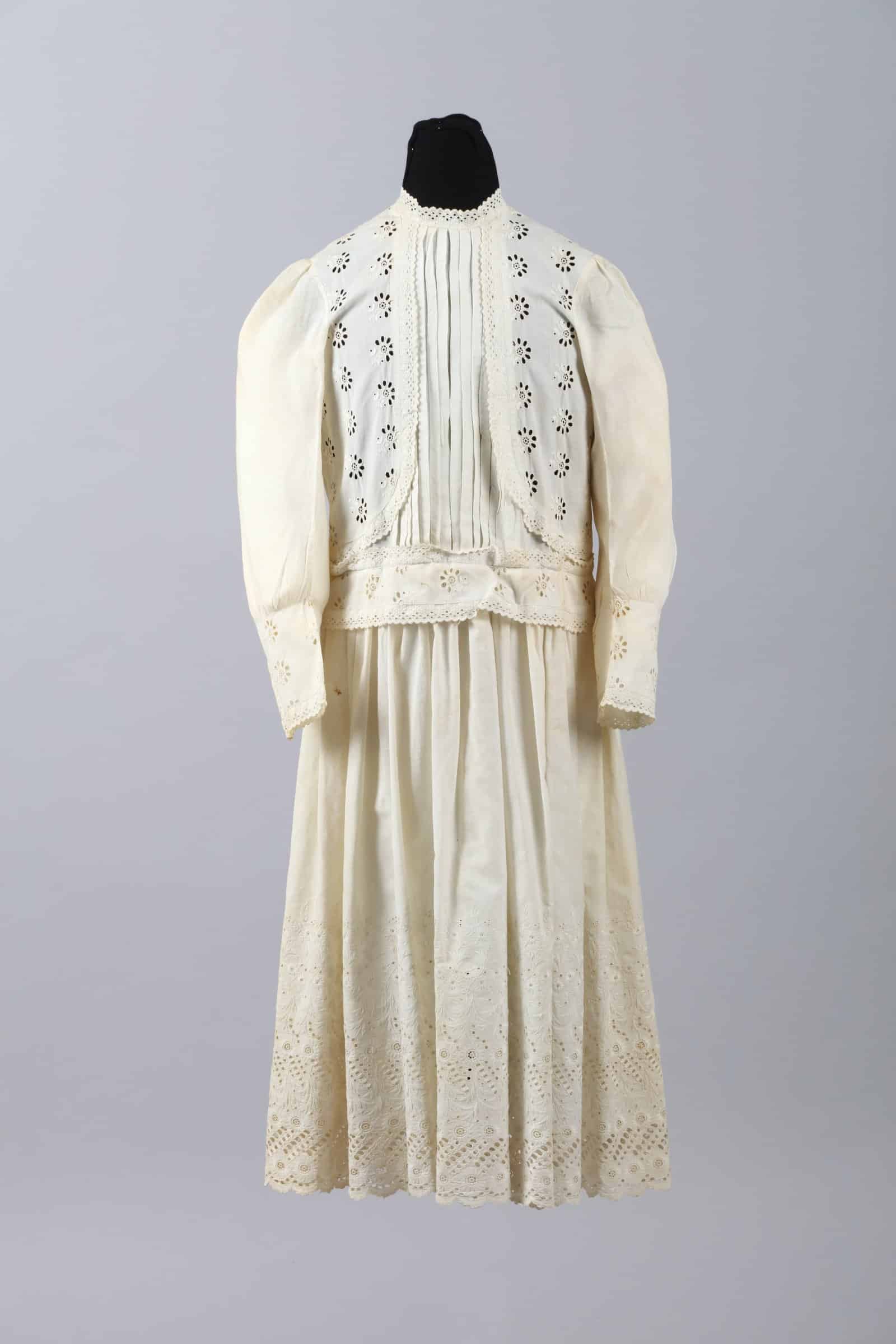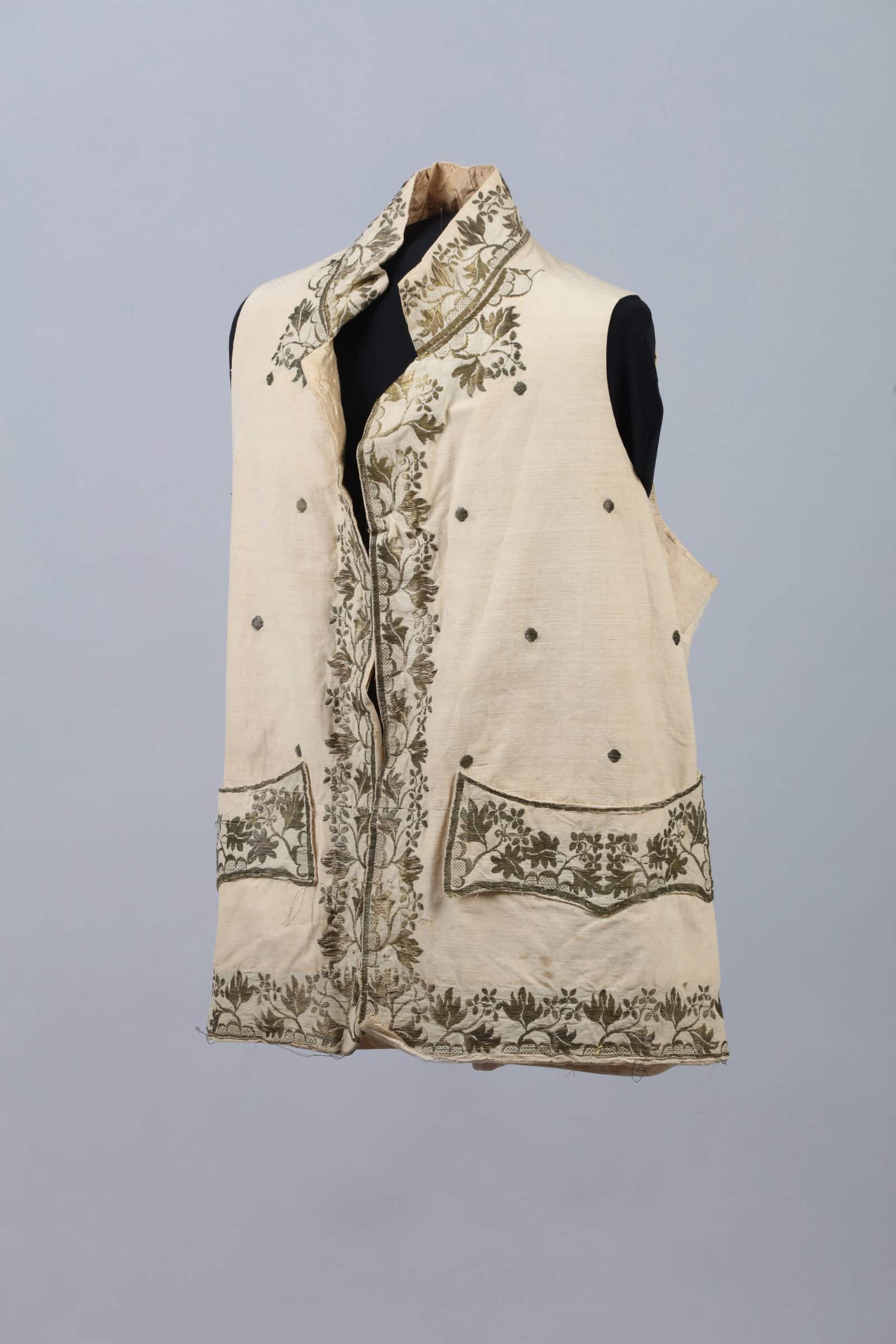Jason Cyrus, 2021 Isabel Bader Fellow in Textile Conservation and Research, uses fashion as a lens to investigate connections between Agnes’s historical dress collection and the Transatlantic Slave Trade, the Underground Railroad and resource extraction.
Using advanced observational tools in the labs of the Art Conservation program at Queen’s University, his research project, History Is Rarely Black or White uncovers these stories in the study of cotton, not only to historically locate materials and their lineages, but to simultaneously highlight the rich legacy of racialized individuals who used clothing to assert their agency at a foundational time in Canadian history.
History Is Rarely Black or White, an exhibition featuring works from Agnes’s dress collection, alongside the contemporary art of Karin Jones, Gordon Shadrach, and Damian Joel, situates this research in historically referenced yet radically future-oriented ways.
An embroidered cotton menswear vest (around 1792–1820), a child’s cotton dress (around 1893), and a young child’s cotton and silk suit (1870–1900) have been a few of the objects in the Queen’s University Collection of Canadian Dress that Jason Cyrus has examined as the 2021 Isabel Bader Fellow in Textile Conservation and Research, along with and Isabel Bader Graduate Intern Anne-Marie Guérin.

Child’s Dress, around 1893, cotton

Waistcoat, around 1790–1820, satin, cotton and gold thread. Gift of Margrethe J Birch and Ian H. Birch (Queen’s Science ’37), 1989.
“I use fashion as a lens to explore questions of identity, cultural exchange, and agency. My research centres the experiences of marginalized communities within material culture as means of advancing decolonization.”
Cyrus and Guérin are examining the material culture of cotton garments through archival research and conservation science. Using a variety of techniques, including isotope analysis, they are working with experts to pinpoint where the cotton was grown. Archival records reveal where the raw material was woven and later sold. Based on their findings, Cyrus and Guérin are mapping a wider supply chain that connects garments at Agnes to resource extraction, Indigenous displacement, the Transatlantic Slave Trade and the Underground Railroad. The Victorian cotton industry played a key role in advancing climate change, global income disparity and the systemic oppression of marginalized communities. Cyrus locates direct connection to Canada through archival materials sourced from the Archives of Ontario.
The research culminates in History Is Rarely Black or White, an exhibition opening at Agnes 27 November 2021. Here Cyrus connects the research on the global cotton industry to its ongoing legacy. Three artists engage cotton’s colonial history to discuss questions of identity and belonging. “Each of these creatives mines their lived experience as a racialized individual with heritage linked to global migration,” says Cyrus. “By doing so, they demonstrate the manner in which the burden of colonial history entwines itself in research, making and daily life.”

Gordon Shadrach, Written in Stone, 2017, acrylic on wood. Courtesy of the artist

INTRO X DJ, Songs of the Gullah Campaign Image, 2020. Courtesy of the artist
2021 marks the tenth anniversary of the Isabel Bader Fellowship in Textile Conservation and Research, generously supported by Dr Isabel Bader. In celebration of a successful decade, two candidates received Fellowships, both of whom bring ground-breaking, decolonial perspectives to textile history and new models of community-based access to museum holdings. Dr Laura Peers and Jason Cyrus began their fellowships in January 2021, both ably assisted in their research by Art Conservation alum Anne-Marie Guérin as the Isabel Bader Graduate Intern in Textile Conservation and Research.
The Isabel Bader Research Fellowship in Textile Conservation is a research opportunity that promotes investigation in textile conservation and costume history. Through the generous support of Dr Isabel Bader, the Fellowship links two of Queen’s University’s most unique resources: the Queen’s University Collection of Canadian Dress at the Art Centre, which comprises over 2000 articles of fashion from the early 1800s to the 1970s, and the Master of Art Conservation Program, which offers Canada’s only graduate degree in conservation theory and treatment.